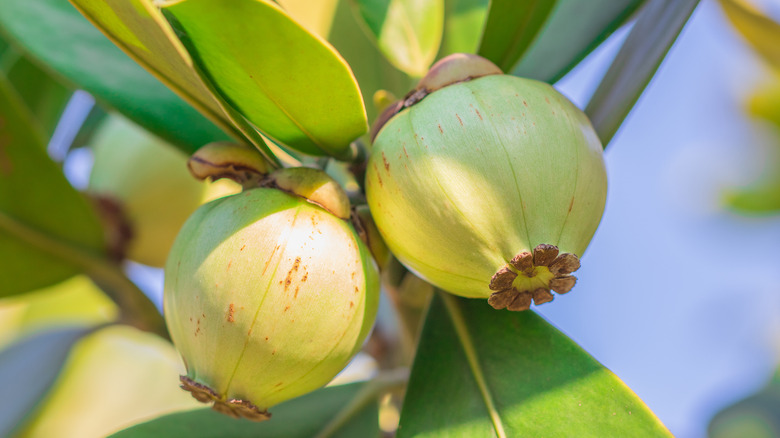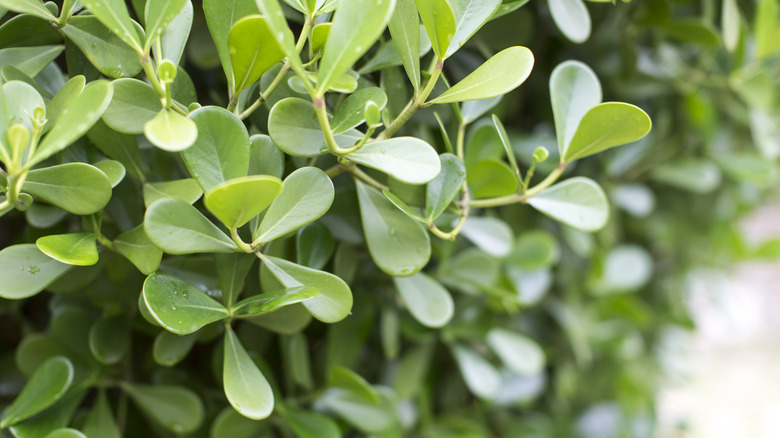Clusia rosea (Clusia for botanist Charles de lÉcluse and rosea for the pinkish color of its flowers) is classified by the Florida Native Plant Society as a long-lived perennial. With broadleaf evergreen leaves and fragrant pink and white flowers that open only at nighttime, these hardy plants are commonly packed together to form a thick hedgerow. Yet they are also popular as singular houseplants commonly called autograph trees, getting this nickname from their leather-textured leaves, which can be carved into with a fingernail or stick. The autographed etchings will remain on the leaves for the plants life or until the leaf falls off.
A second, less often used nickname for Clusia rosea is Pitch Apple. This refers to the only poisonous part of this plant: its fruit. As it ripens, it discharges a black, sticky sap (similar to the resin of pitch pine) that, years ago, was used as caulking material for boats. Autograph trees need a climate zone of 10 or higher to grow outdoors. Within the United States, they are endemic only to a small region in the southernmost part of Florida, where they thrive amongst palm trees and tropical birds. Otherwise, they can grow well in containers so long as they are brought indoors anytime the temperature even thinks about cooling off. Specifically, that translates to keeping your clusia rosea above 50ºF at all times.
An autograph plant, also known as Clusia rosea, can be a beautiful addition to any indoor space With its ability to thrive in low light conditions, it’s perfect for beginners and busy plant parents However, like any plant, it requires proper care and nutrition to reach its maximum potential. Fertilization is key to keeping your autograph plant healthy, vibrant and encouraging new growth. But how do you properly feed these plants without causing harm? Read on for a complete guide to fertilizing your autograph plant the right way.
Why Fertilize Your Autograph Plant?
Fertilizers provide nutrients that plants need to grow and flourish that may not be sufficiently present in the potting soil alone The three major nutrients plants require are nitrogen (N), phosphorus (P) and potassium (K), collectively called NPK Without proper amounts of these nutrients, your plant may experience
- Stunted or irregular growth
- Poor flowering and fruiting
- Loss of leaves and leaf discoloration
- Weakened resistance to pests and diseases
By fertilizing appropriately, you give your plant the minerals it needs to develop strong, lush foliage, produce beautiful flowers, and better withstand environmental stressors.
How Often Should You Fertilize Autograph Plants?
Autograph plants are light feeders that only need occasional fertilization. During the active growing period in spring and summer, feed every 2-4 weeks. It’s best to avoid fertilizing in fall and winter when plants are dormant.
While autograph plants don’t need much fertilizer, it’s important to be consistent with feedings in the growing season. Sporadic applications can cause plant stress and damage.
What Type of Fertilizer is Best?
Choose a balanced liquid fertilizer with an NPK ratio around 10-10-10. This provides equal amounts of nitrogen for lush growth, phosphorus for flowering and fruiting, and potassium for overall plant health. You can also use a slow-release granular fertilizer formulated specifically for foliage plants.
While nitrogen is crucial for plant growth, too much can cause excess foliage at the expense of flowers and fruits. Phosphorus encourages blooming, so opt for a slightly higher P content if you want your autograph plant to produce flowers.
Organic fertilizers like compost tea, fish emulsion, worm castings, or seaweed extract also work well. They release nutrients more slowly than chemical types.
How to Apply Fertilizer to Autograph Plants
Follow the label directions on your chosen fertilizer for proper dilution and application rates. Most liquid plant foods are used at a concentration of 1/4 to 1/2 the recommended strength for houseplants.
Here are some general tips for fertilizing autograph plants:
-
Water the plant thoroughly before fertilizing to prevent root damage from concentrated salts.
-
For liquid fertilizer, dilute with water and apply directly to the potting mix. For granules, sprinkle lightly on the soil surface.
-
After feeding, flush the soil with plain water to wash away any built up salts.
-
Be careful not to get fertilizer solution on the leaves, as it can cause leaf burn.
-
If using compost tea or other organics, strain out any solid pieces before applying to avoid mold growth.
What Are the Signs of Over-Fertilization?
While fertilizer is important, it’s possible to overdo it. Too much fertilizer can accumulate in the soil and cause salt buildup, resulting in leaf scorch, tip burn, or root damage.
Signs that your autograph plant is getting too much fertilizer include:
- Brown leaf tips or margins
- Drooping or wilting leaves
- Fewer flowers and fruits
- Stunted growth
- White crusty buildup on soil
If you notice these issues, flush the soil thoroughly with water to remove excess salts. Hold off on fertilizing for a few weeks to allow the plant to recover.
When in doubt, it’s better to under-fertilize than over-do it. Err on the side of caution with any plant foods.
Common Mistakes to Avoid
When fertilizing your autograph plant, keep these missteps in mind:
-
Using a high nitrogen or imbalanced fertilizer – Stick to a balanced 10-10-10 NPK.
-
Fertilizing in fall/winter during dormancy – This wastes nutrients and can harm roots.
-
Applying too frequently or at too high concentration – Follow label rates to avoid buildup.
-
Failing to water before/after feeding – Always irrigate around fertilizer applications.
-
Getting fertilizer solution on leaves – This can cause leaf burn or discoloration.
-
Not flushing soil to prevent salt accumulation – Flush every few weeks to remove excess salts.
Alternative Ways to Provide Nutrients
Besides traditional fertilizers, there are other tricks to give your autograph plant an occasional nutritional boost:
-
Repot in fresh potting mix annually – New soil contains nutrients.
-
Use compost, worm castings, or compost tea – These add beneficial organic matter.
-
Mix a slow-release granular fertilizer into the potting soil before repotting.
-
Add bone meal or rock phosphate – These provide a phosphorus punch for blooms.
-
Top dress with compost or worm castings – This slow-release feeding avoids buildup.
-
Rotate between organic and chemical fertilizers – Varying nutrients mimics nature.
Ready to Feed Your Autograph Plant?
Now that you know when and how to fertilize your autograph plant, you can provide balanced nutrition for stellar growth. Aim for a 10-10-10 or slightly phosphorus-heavy fertilizer applied every 2-4 weeks during the growing season. Flush the soil regularly and reduce or hold off on feeding if you notice signs of over-fertilization. With a little patience and care, you’ll have a vibrant, healthy autograph plant thriving indoors.

Is the autograph tree toxic?

The Pitch Apple fruit is the one part of a Clusia rosea that is toxic to both humans and pets, causing gastrointestinal irritation and vomiting when ingested. This irritation comes from terpenes, which are chemical compounds produced naturally in the plants that create aromas, smells, and colors related to diverse vegetation types, Healthline writes. Surprisingly, when the fruit eventually splits open, the seeds that come out are not poisonous. Those seeds can be eaten by wildlife, including birds, who often scatter them around, thus perpetuating the growth of new plants.
If this fruit is toxic, why does the autograph tree remain such a popular plant? The answer may lie in the simple fact that they are visibly pleasing and incredibly easy to take care of. It also may be that while consuming the fruit will cause upset, its risk level is not considered lethal. Consider killing two birds with one stone by using a plant stand to elevate your autograph tree to window height. This will allow for better sun exposure while getting the tree up off the floor and away from the curious mouths and noses of pets and children. Then, when young fruit appears after flowering, remove it immediately. Always employ caution in the case of a beloved pet munching on a house plant. As soon as symptoms appear, contact your local veterinarian or the 24-hour ASPCA Animal Poison Control Center.
How to use an autograph tree in the garden

Clusia rosea seeds are often strewn far and wide by birds. New plants grow quickly and are known to naturalize themselves in new areas. This means they spread into non-native environments where they are able to reproduce and grow without human intervention. For the most part, this is seen as a positive aspect since the autograph trees look and general hardiness are sought-after qualities.
Due to their expansive nature and thick waxy leaves, Landscape Plants For South Florida recommends using Clusia rosea in warm climates to create densely packed hedges or privacy screens. Left to grow to their full height, they can stretch up to 35 feet, creating an almost impenetrable wall. The plants have a high salt tolerance, making them a common sight near the ocean, but in non-tropical environments, autograph trees will need to stay in containers and be moved before the arrival of autumn. This way, they can be pruned back to a manageable shape and size and make a nice addition to a garden. More often than not, however, they are sold as indoor house plants.
Achieve Garden Bliss with Clusia Guttifera Shrubs: Tips and Tricks
FAQ
What is the best fertilizer for clusia plants?
When should you not fertilize plants?
Why is my autograph plant dying?
